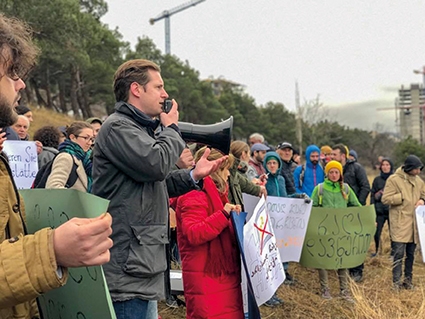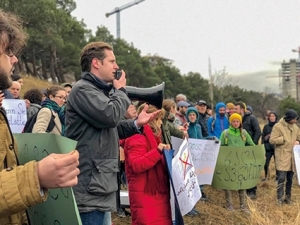The Rise of Urban Activism in Tbilisi
On February 9, urban activists held a protest against the construction of apartment buildings on one of the last remaining green areas on the edge of Saburtalo district in Tbilisi. The protest is one of many recent protests marking the growing influence of activists against the urbanization of Tbilisi’s green areas.
The developer, Optima, also known as m², intends to build a residential complex on a 19.6 thousand square meter plot on Shavishvili Street, close to the Tbilisi State University high-rise building. The development will consist of four 12-storey apartment buildings as well as a kindergarten, sports stadium, and a playground.
Optima claims that 50% of the space will be dedicated to green area, with only 20% used for the development. “The development is permitted to use 50% of the land, but m² intends to only use 20% of the total area,” reads a statement on their website.
However, urban and green activists claim that the development breaches existing regulations. The area of land on which the development is planned has been listed as a “recreational” zone since 2008 as part of the Regular Spatial Plan (RSP). Representatives from Optima dispute this, claiming Tbilisi City Council modified the planning regulations in 2009 but that the changes have not yet been reflected in zoning maps.
Another point of contention is the possibility that the construction area may have been used as a cemetery for WWII Prisoners of War (PoW) during the 1940s and 50s. Irakli Khvadagiani, a researcher from the Soviet Past Research Laboratory has said that topographic and aerial maps from the period as well as statements from people alive at the time suggests that the cemetery was there. Although they have not carried out definite research, preliminary results lead them to believe that PoWs worked in a brickwork factory in the area. Activists want further research to be conducted to ensure that the PoWs are properly remembered.
The protest on 9 February comes a few weeks after officials reversed the decision to allow the construction of Budapest Hotel in Vake Park. Activists criticised the hotel plans as it would destroy another green area in Tbilisi. During a meeting on January 25, Tbilisi Mayor Kakha Kaladze congratulated activists for protecting Tbilisi’s green spaces: “Vake Park has won. I would like to congratulate Tbilisi and the Tbilisians. We have managed to reach an agreement, and nothing will be built on the Vake Park territory.
The movement against uncontrolled urbanization has united left-wing activists, the green movement, those interested in history and other concerned citizens. Various NGOs and student groups such as My City is Killing Me, Green Alternative, Guerrilla Gardening Tbilisi, Emc, Tiflis Hamkari, Initiative for Public Space, and My City - Union of Citizens Concerned and Caring for the City have been at the forefront of calls to stop urbanization. A few hundred people joined the protest held on 9 February which was organized by various groups.
Their concern lies in the lower quality of life in Tbilisi when green spaces and historical heritage are destroyed. Activists blame a poor vision of Tbilisi’s future as well as collusion between developers and city officials. Poor urban planning makes cities less habitable whilst also endangering life and the health of citizens for both the current generation and generations to come.
By Amy Jones
Image source: My City is Killing Me Facebook Page












